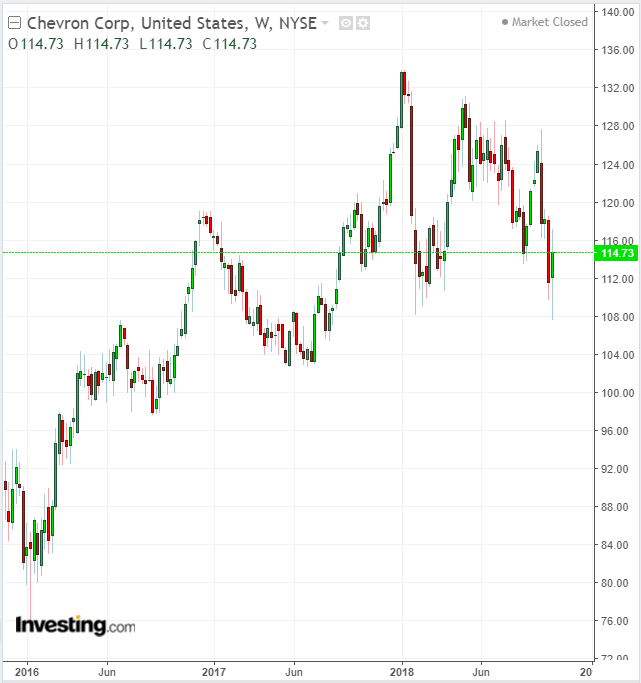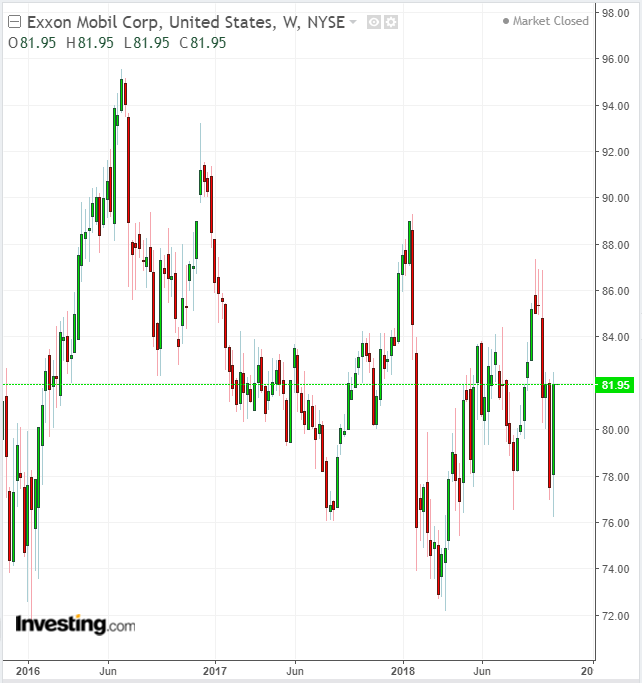US oil majors, based on their Q3 earnings reports, haven’t lost their power to surprise. After years of belt-tightening and restructuring efforts, both ExxonMobil (NYSE:XOM) and Chevron (NYSE:CVX)—our two favorite names in this space—have triumphantly come back from the 2014 oil-market slump.
Both delivered their strongest third quarter results in four years, each showing the kind of profitability that investors haven't seen since the days when crude oil was trading at $100 a barrel. As well, each company's free cash flow is surging.
Yet even with this optimistic outlook, it’s still no simple matter to pick the right oil stock. Uncertainty over the future of oil prices is increasing. Over the past few weeks the price of crude oil has dropped almost 20%, currently trading just above $60. Some experts believe oil is likely to head back to and stay above $75 a barrel, as the US sanctions on Iran limit supply.
But others forecast a limit to this upside move. They see demand growth slowing next year, a result of ongoing trade wars and economic weakness.
While it’s almost impossible to accurately predict the short-term direction of volatile oil markets, you can still pick the stock of an oil producer based on the company’s ability to reward investors through a growing stream of dividend income.
Growing dividends offer a great hedge to ride out the volatility of oil markets while focusing on the long-term gains. By keeping this theme in mind, it’s much easier to zero-in on the premier oil stocks in order to buy the best names. Using this criterion, both Chevron and Exxon look very attractive.
Expanding Production
After years of innovation and investment, both companies are now in a position to quickly ramp up output in order to benefit from strength in oil markets and produce hefty cash flows. Evidence of this was visible in their latest earnings releases.
Both companies reported double-digit production increases in the Permian Basin, the shale region in Texas and New Mexico. The Permian now makes up 11% of Chevron’s overall output whereas Exxon now has 38 rigs running in the region. In Exxon's case the company unit responsible for shale production reported its third-straight quarterly profit.
The growing output from each company's shale operations is a major shift from their traditional approach to production, which required massive investment and long-term planning to ramp up output. By deploying new fracking techniques, each of these producers can drill wells in a matter of weeks.
During the quarter, Exxon’s earnings climbed to $6.2 billion, up 57% from a year earlier, while Chevron reported its profit doubled to $4 billion. Exxon also had its best reading in four years for cash flow from operations, a key measure of financial health for oil companies.
Exxon shares, currently trading at $81.95, offer a dividend yield of 4.11%, with a payout ratio of 63.75%. Chevron, which closed Friday at $114.73 per share, has a dividend yield of 4.03% with a payout ratio of 69.29%
Long-Term Income Appeal, Divergent Approaches
Though each company affords stakeholders long-term income appeal, each has taken a different approach to their growth journey.

Chevron is keeping spending low and trying to squeeze more juice from existing assets. According to management, it intends to maintain low levels of capital spending ($18 billion to $20 billion annually) from 2018 to 2020.
That means the company has more cash available to return to investors. According to its Chief Financial Officer Pat Yarrington, the company would consider raising its stock buyback from the current $3 billion level.

Exxon, on the other hand, has no plans for buybacks. Instead, the company is focusing on steadily raising its dividend and investing aggressively in mega-projects from Guyana to Mozambique. The latter is one of the best projects the company has pursued since Exxon and Mobil merged about two decades ago.
Bottom Line
Both Exxon and Chevron have traditionally provided investors with growing dividend income and solid capital gains over the long-run. Their 4%-plus dividend yields look attractive, perhaps moreso at a time when each company is entering a fresh growth phase driven by new technology and a low cost base.
The remarkable recovery in each of their cash flows in 2018 provides another strong signal that the timing is opportune for income investors to snap up the shares of either—or both—of these oil giants.
